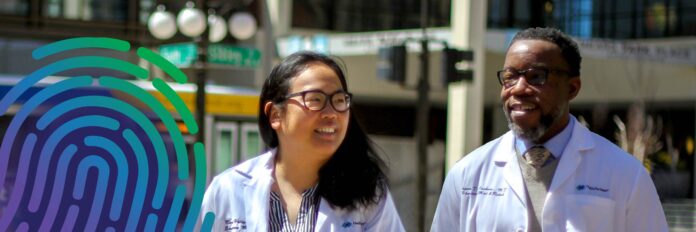Balanced eating is good for everyone, but it’s especially important for people living with diabetes or other chronic conditions. The problem is that most nutrition advice in the U.S. is geared toward the majority culture, leaving folks from other food cultures to figure things out on their own.
That’s where the “Honoring Different Food Cultures” initiative comes in. They’re working to close that gap and make nutrition guidance more inclusive.
In this episode of the Off the Charts podcast, you’ll hear from two members of the initiative: Dr. Yeng Yang, a regional director of primary care and co-chair of the Health Equity Cabinet, and Munira MaalimIsaq, a family nurse practitioner.
Dr. Yang and Munira talk about why culturally responsive education matters, and how they helped create materials that meet people where they are, showing that even white rice can be part of a healthy diet. Listen to the episode or read the transcript.
Noticing that nutrition advice misses the mark
“This has been a project that has been long in the making, long in the dreaming, really,” Dr. Yang says.
As a primary care doctor, she started to notice that patients from different cultural backgrounds weren’t getting the support they needed when it came to managing diabetes, high blood pressure or other chronic conditions. Even when they were referred to a diabetes educator or nutritionist, the advice didn’t always connect. A main reason seemed to be that the guidance didn’t take their food cultures into account.
Dr. Yang recalls, “They come back, and they say, ‘That doesn’t work, because none of the food they show me on those pictures look like the food I eat at home.’”
Not only that, but these patients were often told that they shouldn’t eat certain foods that are mainstays of their diet, including white rice. And that, in Dr. Yang’s opinion was not okay.
Honoring the cultural significance of white rice
“Rice is life for us,” Dr. Yang says, speaking as part of the Hmong community. “And rice is life for many, many, many cultures across the world.”
For some, white rice isn’t just a dietary staple, but also part of identity. And even when told that brown rice has more nutritional value than white rice, it’s not a swap that they’re willing to make.
Dr. Yang explains that, in some communities, brown rice is viewed as food for the less fortunate. On the other hand, white rice is seen as a premium product or symbol of status.
“Because of some of those social stigmas that are culturally relevant, you tell people, ‘go eat brown rice,’ that’s a problem,” Dr. Yang says. “They might smile at you and say, ‘sure.’ But they’re going to go home and not do it … they’ll just substitute white rice.”
Taking steps to honor different food cultures
The “Honoring Different Food Cultures” initiative (nicknamed the “White Rice is Okay” group) was formed in 2023. Supporting this initiative is a cross-functional team that includes primary care, diabetes education, nutrition services, quality and patient education.
Early on, the group had listening sessions with people from the Somali, Hmong and Ethiopian communities. The goal was to “get their perspective and make them the center of what we wanted to change,” says Munira.
During the listening sessions, participants noted that the educational materials used to show balanced eating tended to include food choices from a western diet (for example, skinless chicken breast, broccoli, mashed potatoes, strawberries and a glass of milk).
“That’s when they pointed out to us that, ‘Well, I don’t recognize that food. Like, you can teach me how to portion mashed potatoes, but I’m going to go home and eat rice. You can teach me how to portion whatever fruit, but I’m going to go home and eat mango or dates,’” says Dr. Yang.
Helping patients visualize balanced food choices
The team was inspired to help people from different cultural backgrounds see how the foods they know and love could fit into a healthy diet.
The MyPlate guidance from the U.S. Department of Agriculture served as an inspiration for how to visually provide this information. The icon for MyPlate features a plate separated into sections for vegetables, fruits, grains and protein with a cup for a serving of low-fat dairy on the side. While MyPlate is intended to be simple and flexible, it can be challenging for people of other food cultures to balance food choices, based on what’s typical in their diets.
Working alongside community members, the team developed “Healthy Eating with My Meal,” handouts that show examples of culturally appropriate foods in the proportions that are recommended for a healthy diet. All the information on the page has been translated, allowing people to read the information in their native language or English.
For example, the My Meal handout for the Hmong community (PDF) leads with pork and mustard greens soup, then goes on to show culturally relevant examples of nonstarchy and starchy vegetables, grains, proteins, fruits and dairy products (or dairy alternatives). Instead of lettuce, there’s chayote. Instead of potatoes, there’s sweet potatoes. And as you can guess, white rice is one of the grains that’s listed.
“Because this is designed to be culturally appropriate for them, they will immediately recognize their food,” said Dr. Yang. This spurs the conversation about what they usually eat, and if the food isn’t currently represented, it can be added to the handout. And when the patients take the handouts home, they have a visual guide to help them make balanced choices to support their health.
Referring to the My Meal handout for the Somali community (PDF), Munira says, “For my community that does not eat a lot of vegetables, this was a good conversation starter when it came to how much vegetables are important, and fruits are important – and how do you integrate that in the meal.”
Along with the My Meal handouts available in Somali and Hmong, there are also Somali-language videos and audio recordings to support diabetes education. To make access easier, QR codes linking to these resources can be added to after-visit summaries. Plus, the videos are included on hospital menus, helping patients make balanced food choices that support their health. The team hopes to create additional materials, including ones for other food cultures.
A recipe for joy and better health
“The data tells us that when people trust us, when people understand and identify with the education and the care that we give them, that they are more engaged and they feel more empowered,” said Dr. Yang.
Munira recalls an early experience of sharing the My Meal handout. “I remember the first time I pulled it out for a patient; she just takes it out of my hand … and she hugs it. She’s like, ‘This is for us, this was made with us in mind.‘”
Dr. Yang says that there are well over 100 randomized trials showing the positive impact of culturally responsive education for diabetes. The main takeaway is that when you show that you understand and provide culturally appropriate guidance it allows people to help themselves.
“And that leads to better glycemic control and hopefully better outcomes in terms of decrease in complications, which is ultimately what we want,” says Dr. Yang.
Setting the table for culturally responsive guidance
Now that dietary recommendations can be provided in a way that’s easier to digest, the question is how to get more people to feast on that information.
Right now, these tools are mostly used by our diabetes educators, nutritionists and a small number of primary care clinicians. But given the profound impact that these tools seem to have on patient care, Dr. Yang and Munira are hoping to see them in more widespread use. While the materials are available to all HealthPartners clinicians, Dr. Yang says that it’s often best to refer patients to a certified diabetes educator or a nutritionist.
“Why I harp so much about seeing the diabetes educator is because it’s really a partnership between a primary care clinician and our diabetes education team,” says Dr. Yang. “We have really good evidence to show that when we actually work in partnership, we produce better results for our patients. Our patients go home faster, they stay at goal longer, and that’s really ultimately what we want.”
But getting someone connected with a diabetes educator or nutritionist isn’t always easy. Results from a survey of HealthPartners primary care clinicians and endocrinologists showed that clinicians can sometimes be unsure of how to best provide guidance to people of other food cultures.
“Clinicians who may not do this work a lot or may not see these kinds of patients a lot, they’re afraid to offend people, and they may not ask the right questions,” says Dr. Yang.
To help, the team developed a resource to help clinicians know how and when to refer people of other food cultures for diabetes or nutritional education. Some key recommendations include acknowledging patient concerns, practicing cultural humility, sharing information and making sure to follow up.
To Munira, follow-up is especially important. She feels it’s vital that you let your patients know that you’re not just passing the buck. Instead, it should be a warm hand-off where you’re saying, “I trust this person, and this is someone that you will have longer time with, and everything gets sent back to me, and I’ll review it.”
Serving up changes that heal people and help communities
“Many of our patients from these different food culture communities, they are really afraid of medicine,” says Dr. Yang. “But food is so fundamental … and when you can actually lead with food, rather than leading with medicine, it goes a long way to build that trust.”
What’s more, the positive experience and health outcomes of one person has the potential to make positive waves throughout a community.
Munira says that for people in the Somali and Hmong communities, “whatever we learn, we’re teaching other people and sharing with our community members. Something like this, I can see it having a big impact on a whole family and even communities.”



